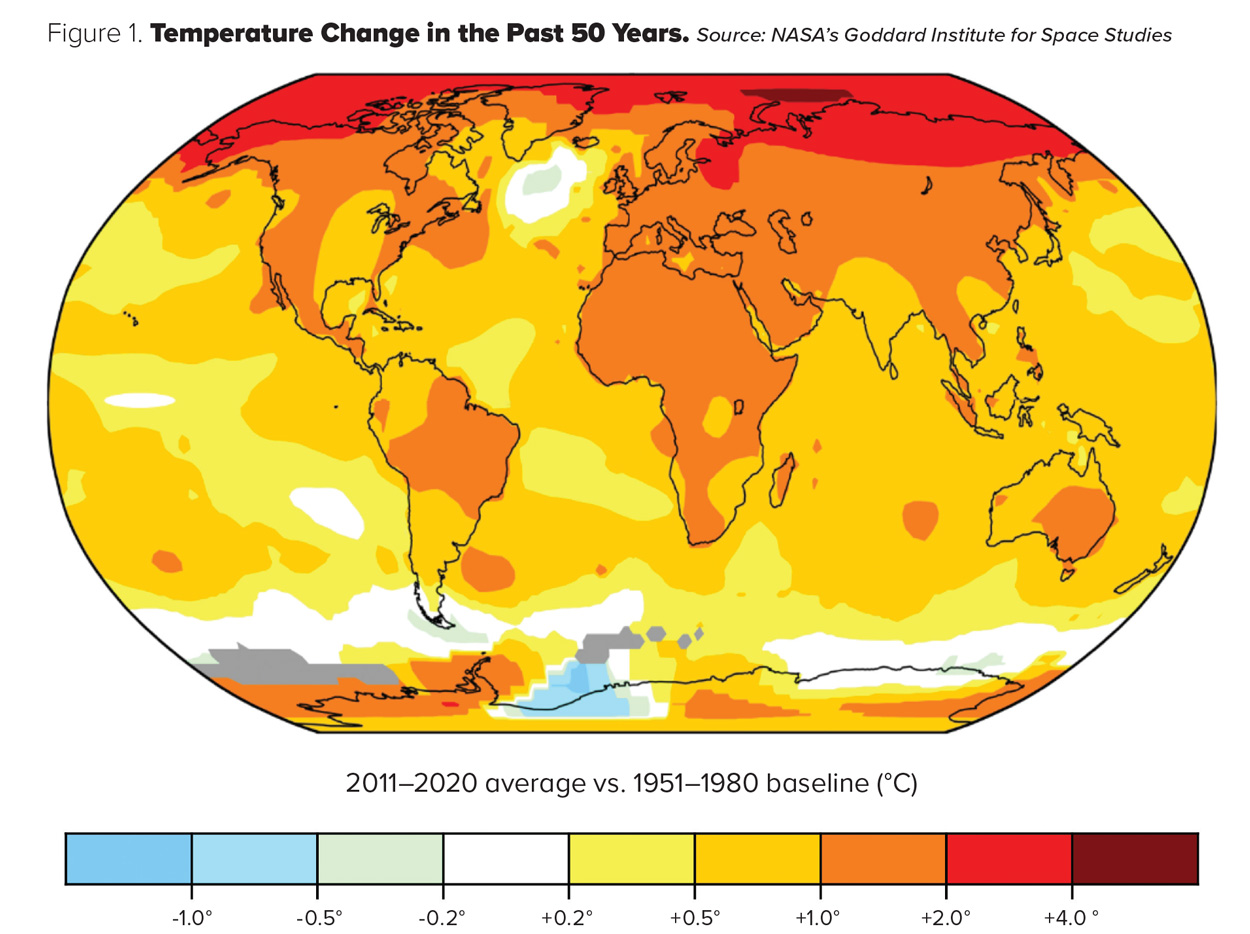What Does Climate Change Mean for Food Safety and Security?
Safety & Quality | APPLIED SCIENCE
As far back as 1896, Nobel laureate Svante Arrhenius calculated that the carbon emissions from human activities during the Industrial Age were sufficient to cause global warming. Society’s long-ago curiosity has since evolved to increasing concern, then to dire predictions, and finally to consensus among atmospheric scientists, numerical modelers, and environmentalists: Climate change is here, and its consequences are enormous.
The record temperatures reported by meteorologists and the increasing natural disasters of epic proportions tell the tale of global climate shifts. While the social and political ramifications are myriad, agriculture is suffering the most profound effects. The impact on agriculture, in turn, directly relates to food safety and security, resulting in local scarcity, adverse health outcomes, and the need to develop mitigation strategies.
Strengthened Microbial Agents
Climate change has affected the world’s oceans in many ways besides warming water temperatures. Melting snow and ice have caused rising sea levels, increased flooding, and saltwater intrusion in coastal areas, boosting the risk of human interactions with pathogenic Vibrio species (Froelich and Daines 2020).
“The ‘Vibrio season’ is expanding as warmer temperatures extend into the fall months,” says microbiologist Dayle Daines, associate professor emerita at Old Dominion University. “Because these bacteria have such short generation times, replicating in 20 minutes or less, they are able to react quickly to rapid changes in environmental conditions.” The organism is also moving into higher-latitude areas when these regions experience unprecedented heat waves (Froelich and Daines 2020).
One study found a strong association between salmonellosis and extreme precipitation caused by storm events (Morgado et al. 2021). Other bacterial pathogens that could be enhanced by climate change include Campylobacter, Shiga toxin-producing Escherichia coli, Clostridium, Yersinia, Listeria monocytogenes, and Leptospira (Tirado et al. 2010). Viruses such as Rift Valley fever, Nipah, Hendra, Hantavirus, hepatitis E, and tick-borne encephalitis may be able to be transmitted from animals to humans more commonly (Tirado et al. 2010). Likewise, exposure to parasites such as tapeworm, liver fluke, protozoa, Toxoplasma gondii, cryptosporidium, and Giardia is more likely to occur (Tirado et al. 2010).
Mycotoxin Risks
Mycotoxins are ubiquitous fungal species that commonly grow in many crops. They produce toxins that cause adverse health effects when consumed by humans and animals.
Mycotoxins primarily cause disease in poor communities when food is scarce and people are forced to eat low-quality grains and produce. Monitoring of the recent drought and flooding in Serbia, for example, has confirmed that one of Europe’s leading agricultural areas is at risk for adverse health effects from consumption of mycotoxins in damaged crops (Milicevic et al. 2019).
Insect Pests
Global temperature increases allow insect pests to thrive in areas that once were too cold for them. Warmer temperatures enable some species to grow larger, breed longer, produce additional generations, and increase their resistance to pesticides. This affects food safety when insects damage plants, making them more susceptible to mold infections that produce mycotoxins. Insects like ticks can also serve as vectors for livestock diseases.
One unexpected consequence of global warming has been the spread of destructive ants. For example, Tawny crazy ants, which are attracted to and chew on electrical insulation and wiring, are presently invading the Gulf Coast of the United States, moving up from Colombia in South America, where they displaced all other ant species. We may be forced to use more pesticides as a result of insect pest migrations via crop imports, which adds another risk to the food chain, and additional testing and monitoring of crops may be necessary.
Water Quality
“The safety of food is intimately tied to the safety of water,” says Lee-Ann Jaykus, William Neal Reynolds Distinguished Professor in the Department of Food, Bioprocessing and Nutrition Sciences at North Carolina State University. “If climate change causes the water supply to be less abundant or more prone to contamination with pathogens, this will have downstream food safety impacts. We will need to develop microbiological and chemical criteria and minimum standards for recycled water.”
Water will become scarcer in many regions due to the combined effects of climate change and population growth (Ding and Peterson 2012). Intensively irrigated areas in western Kansas, for example, are expected to drain the Ogallala Aquifer in less than 50 years, but some areas are already to the point of effective exhaustion of supply (Ding and Peterson 2012).
The fastest warming on the planet is happening in the Arctic where the permafrost is melting, lowlands have been flooded with seawater, and chemical contaminants are being released into water sources from permafrost and erosion (Harper et al. 2020). This has impacted drinking water quality and availability for circumpolar communities because many rely on surface water for drinking and cooking (Harper et al. 2020).
Crop Nutrient Density
Increased temperatures and carbon dioxide levels can lower the nutrient levels of some crops as well as total crop yields (Macdiarmid and Whybrow 2019). One meta-analysis showed that zinc, iron, and protein concentrations in wheat, rice, field peas, and soybeans were significantly lower when crops were grown at elevated carbon dioxide levels (Myers et al. 2014). The phytate content of the crops tested was also reduced, however, which theoretically could increase the bioavailability of these nutrients and counter some of the losses.
Coping Strategies
“If we accept that this [climate change] problem is real, maybe it’s just too big to do anything about. And, you know, there are a lot of people who go straight from denial to despair without pausing on the intermediate step of actually doing something about the problem,” Al Gore said in his 2006 documentary, An Inconvenient Truth. So what can we do to mitigate climate change from a food science and agricultural perspective?
On the front end, we can reduce food waste to decrease global carbon emissions, produce foods with a lower carbon footprint, shift from livestock to more plant-based protein sources, and grow crops that sequester carbon dioxide. To combat the spread of insect pests, we can identify their native predators—usually beneficial wasps—and harness these wasps as biological controls.
In the case of Vibrio, the consumption of raw or undercooked shellfish just may not be feasible anymore. Proactively, the European Centre for Disease Prevention and Control (ECDC) has developed a platform called ECDC Vibrio map viewer to monitor environmental waters for conditions favorable to Vibrio growth, using remotely sensed sea surface temperature and salinity (Semenza et al. 2017). Predictive early warning systems could be set up for waters in other parts of the globe.
Other scientists are promoting oyster bed farming and restoration to combat climate change by filtering algae and sediments from the waters, enhancing marine diversity, and using oyster shells to sequester carbon and as alternatives to hard structures like seawalls (Yeh et al. 2021). In addition, assistant biology professor Brett Froelich’s lab at George Mason University is developing a probiotic treatment for oysters to hinder competing pathogenic bacteria and reduce human infections.
Planting Seeds for the Future
When Arrhenius first predicted global warming in the 19th century, he thought it was a good thing. And it’s true that for some global regions, climate change has increased the growing season for certain crops. In Ukraine, for example, climate change will have a positive impact on grain production—scientists project grain yield in that region may increase by 25% in 2025 (Tarariko et al. 2017). Other higher-latitude regions also may benefit from longer growing seasons for traditional crops or gain the opportunity to propagate new ones.
Some farmers will have to find variants of old crops or new crops or systems to accommodate the changing weather. Farmers in the Philippines discovered that saltwater intrusion was reducing rice production, so they found rice varietals with a high salt tolerance (Terrell 2021). Hawaii farmers are planting more macadamia nut trees because tree crops are more resilient than other crops and sequester carbon in the soil (Terrell 2021). Crops that are adapted to higher carbon dioxide levels also need to be identified and propagated.
As stakeholders in agriculture, food safety, and food security, we will have to create an ongoing dialogue with policymakers to increase awareness and fund potential solutions. This will require constant monitoring, more mathematical modeling and predictions, updated microbial and chemical testing criteria, and innovations in crop production and livestock husbandry.
Learning Objectives
- Understand how climate change is not a future problem—it is already here.
- Assess expert predictions that identify food safety and security issues caused by climate change.
- Understand how water safety is a key part of food safety.
- Understand how increased occurrence of catastrophic weather events such as hurricanes, flooding, and drought may have a larger impact on food safety than global warming will.




